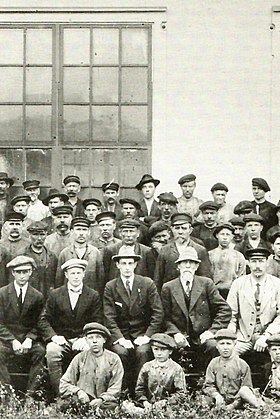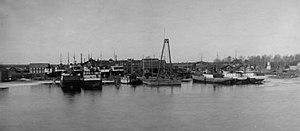Lehtoniemi (company)
| Oy Lehtoniemi Ab | |
|---|---|
| legal form | Corporation |
| founding | 09/15/1902 |
| resolution | 1929 |
| Seat |
Lehtoniemi , Joroinen Grand Duchy of Finland (→ 1917) Finland (1917 →) |
| management | → The managers |
| Number of employees | 146 |
| sales | 4.9 million Finnish marks |
| Status: 1923 | |
Oy Lehtoniemi Ab was a Finnish workshop and shipbuilding company that operated from 1902 to 1930. The shipyard was located in Lehtoniemi , Joroinen in the Mikkeli province on Lake Saimaa .
The company was founded by Baron Carolus Wrede to continue the operation of the previously bankrupt entrepreneur Tehtaat Lehtoniemi & Taipale Fabriker . He resumed business under the old name. Wrede invested in the facilities and business flourished again. The corporate form was changed to a limited liability company Oy Lehtoniemi Ab in 1917 and the ownership base expanded.
The portfolio consisted of ships , steam boilers , steam engines and pumps . A large proportion of the customers came from the Russian Empire and later from the Soviet Union .
Oy Lehtoniemi Ab was discontinued in 1930 and its systems were sold to A. Ahlström Oy . The factory closed in 1951.
background
The history of shipbuilding at Lehtoniemi began in the 1880s, when engineer Torsten Forstén bought a piece of land and started building ships with his business partner Albert Krank. Krank had started business as early as 1886 in a rented area near the Taipale Canal . The company name was Tehtaat Lehtoniemi & Taipale Fabriker . The first ship named Salmi was completed in 1889. The following year two more ships, Suvas and Kalla , were built for the same customer. The quality was high and the order intake increased. Forstén left the company in 1892, after which Krank ran the company alone. He was an innovative and enthusiastic engineer who received many patents . Much of the production went to Russia. In 1896, the company built a paddle steamer for a Moscow- based customer and the icebreaker Yermak , which went to Vladivostok . Both ships were delivered in parts and assembled in Russia because they were too big to fit in the Saimaa Canal .
The company also built its own fleet, which included about ten ships. The ships transported cargo and pulled barges and tree trunks.
The company went bankrupt due to an economic recession in 1901 and Krank died the following year.
Restoration
The property was bought on September 15, 1902 by Freiherr Carolus Wrede. He resumed operations under the same name, Tehtaat Lehtoniemi & Taipale Fabriker . Wrede appointed the engineer Harald Staffans as technical manager and invested in the modernization of the plant. The shipyard then experienced a new boom. In 1910 a new roller slip system with a winch was completed. In 1914 a large, modernly equipped boiler shop followed. The wood used at the shipyard was sawed in its own sawmill .
The raw material was transported by water, but in the winter months by horses from Pieksämäki station . Transportation became easier when a railway line to Varkaus was completed in 1913 and a stop was built in Lehtoniemi.
Expansion of the owner base
Business was good in the 1910s, but since production and materials tied up a lot of capital, the company was prone to economic downturns. The reduction in orders from the Imperial Russian Army as its most important customer led to difficulties. The corporate form was changed to a limited liability company on January 15, 1917 under the name Oy Lehtoniemi Ab . Part of the shares were sold to the Saint Petersburg businessman Harald Lundsten and Emissioni Oy. The facilities could now be further modernized. The compressor system , which was installed in the summer of 1922, increased productivity , and a new joinery followed in 1927 . The company received more orders and production achieved its goals.
In 1925 the company owners were Liittopankki Oy with 45%, Kansallis-Osake-Pankki (28%) and Wilhelm Wahlforss (17%). By 1928, Liittopankki's ownership had increased to 51%.

The managers
The following engineers worked as Lehtoniemi directors.
| Term of office | Surname | ||
|---|---|---|---|
| 1905-1912 | Fredrik Borg | ||
| 1912-1914 | A. Åkerman | ||
| 1914-1916 | Rabbe Wrede | ||
| 1917-1921 | Armas Nikander | ||
| 1921-1925 | Wilhelm Wahlforss | ||
| 1925-1928 | TW Runeberg | ||
| 1928-1929 | Martin Dahlberg | ||
Workforce
A community of workers grew around the factory. The number of workers varied depending on the workload. The greatest number of workers was over 600. Many of the workers lived in their own homes or in nearby homes. Initially there were seven houses with factory apartments, later more were built. As was customary at the time, the factory took care of the workers and their families. The workers had health insurance , a library and a reading room . The workers' children could go to the company's school. Leisure activities also flourished: the workers had a choir , a brass quartet and a gymnast group .
The Lehtoniemi workers' association was founded in 1904. The association was active from the start and also became a member of Varkaus, where the local A. Ahlström factory management did not tolerate any labor movement . The association planned to build a community hall, but the project was canceled due to a strike on April 20, 1906. The strike soon ended as a large proportion of the workers broke the strike and did not become unemployed. The striking action has long weakened the workers' community.
End of production
The company was hit by a recession in the late 1920s and closed in 1929. Total production, including the Albert Krank era, comprised 205 coastal and inland shipping vessels , the largest being the port icebreaker Suursaari . Almost half of the production was sold to Imperial Russia and the Soviet Union. Products other than ships included 360 steam boilers, approximately 350 steam engines of various sizes, and a range of salvage pumps , steam winches and warping winches .
The Lehtoniemi plants were taken over by A. Ahlström Oy the following year. Various small parts were manufactured in the facilities. In the 1940s, it was mainly soundproofing articles and the factory was called Ääniteknillinen tehdas ("acoustic factory"). The factory made doors, windows, building panels, furniture, boats and their kits. In 1965 the factory was finally closed.






